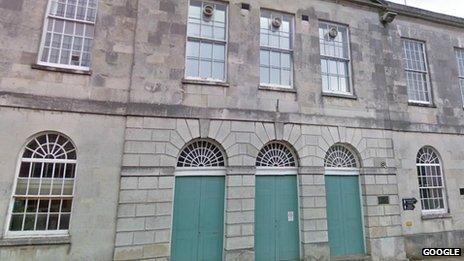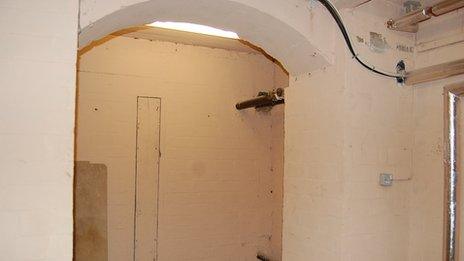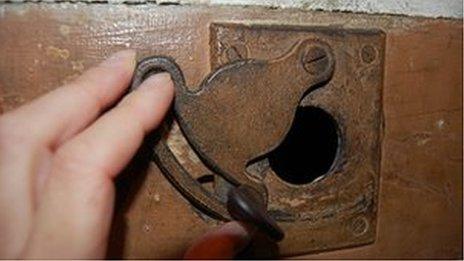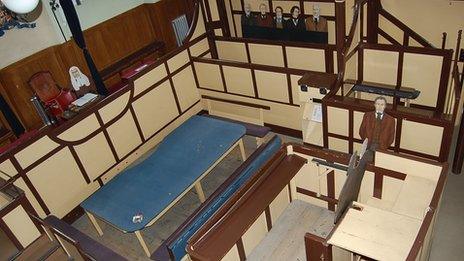Tolpuddle Martyrs trail building Shire Hall's £2.5m revamp
- Published

Novelist and poet Thomas Hardy was a magistrate at the court for 15 years
Over the centuries it has seen the dramas of justice played out within its walls - drunken judges, murderers sent to the gallows and the trial of the Tolpuddle Martyrs.
But now Dorchester's Shire Hall, which houses the town's old court house and cells, is set for a £2.5m makeover as a visitor attraction which will include live performance as well as the usual audio and video guides.
According to Alistair Chisholm, Dorchester's tour guide, it is an appropriate use for the Grade I listed building, given the court's "pantomime" past.
"Court in the early 19th Century was a huge social occasion and source of entertainment. There would even be back-chat between the barristers and the spectators," he said.
"It was a theatre within which your social standing was very clear and this hierarchy was reflected in the building.
"The judge had his own entrance, the grand jury had their own room at the top of the building and their own place in the court, the prisoners had a separate entrance, as did the public."
The site has been a centre for justice since medieval times.
The existing building, owned by West Dorset District Council, was constructed between 1796 and 1800 and remains largely unchanged.
Jo Cox, of Keystone Historic Building Consultants, described it as publically-owned courts rich in history as "increasingly rare".
"To see the nuts and bolts, the panelling and the fittings that go with that time in history, is an extremely interesting experience," she said.
The court's most infamous trail occurred in 1834 when six farm labourers, under pressure from widespread cuts to wages, formed a "friendly society" and swore an illegal oath to protect their incomes.
"At the time of the Tolpuddle Martyrs trial it was your job to establish your innocence," Ms Cox added.
The men failed to do so and were sentenced to seven years' transportation to an Australian penal colony.
But outrage about their punishment caused protests across England and after four years they were pardoned and returned home.
The case is still celebrated each July in the Dorset village they came from and their cause is widely recognised the birth of trade unionism in Britain.
'Drunken judges'
Tim Lezard, spokesperson for South West TUC, described them as "hugely inspirational figures".
"History tends to be about kings and queen and less about ordinary people.
"They changed the course of history forever and by investing in Shire Hall their plight will be further highlighted," he said.
There were plenty more colourful characters that passed through the courts' doors in its 150 years, the last case being heard in 1955.

The Shire Hall project has received initial funding from the Heritage Lottery Fund and West Dorset District Council for design and planning work.

During the Cold War part of the building was converted into a bunker for "high standing figures" in Dorset

As well as former judge lodgings, there are 12 cells - two original communal cells and 10 additional solitary cells built during Queen Victoria's reign

As part of the project a sample of the Dorchester Quarter Session records from 1709 - 1971, are being conserved and digitised for exhibition at Shire Hall

Shire Hall was used by local government from 1889 until 2012 when West Dorset District Council moved to new offices on Charles Street
'Hanging judge' Jeffreys
The building also hosted the travelling Courts of Assize.
"A judge from London would hear the most serious court cases in Dorchester and would then travel on to the next town, like Exeter or Bodmin for example," Ms Cox explained.
"The Western Circuit, as it was known, brought a great wave of barristers and lawyers and even had its own wine carriage.
"There would be a great military procession, plus balls and assemblies would be held which brought people into the town and had a huge impact on local life."
Judge Jeffreys, known as the "hanging judge", sentenced 200 people to death at his "bloody assize" in the town in 1685.
"Those executed were supporters of the Duke of Monmouth, who staged a failed rebellion following the death of his father King Charles II, to seize the throne," explained Mr Chisholm.
"Another 800 were sold to slavery and sent to Barbados."
In its current state Shire Hall sees up to 2,000 visitors each summer and it is hoped the proposals will boost numbers.
They are currently under public consultation until 15 September and the new visitor centre is expected to open by summer 2016.
- Published14 July 2012
- Published18 July 2010